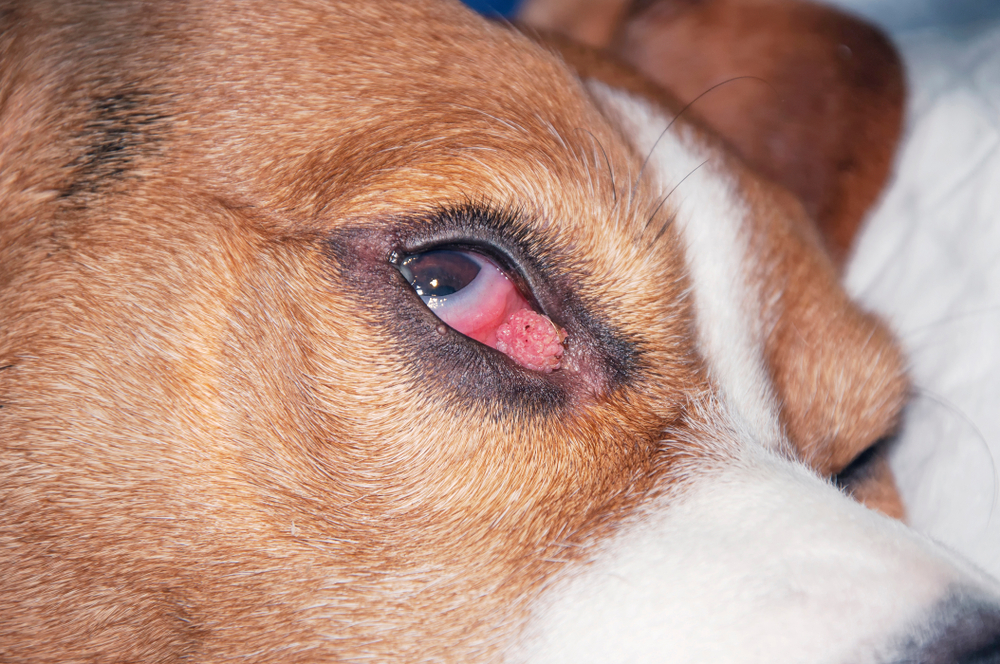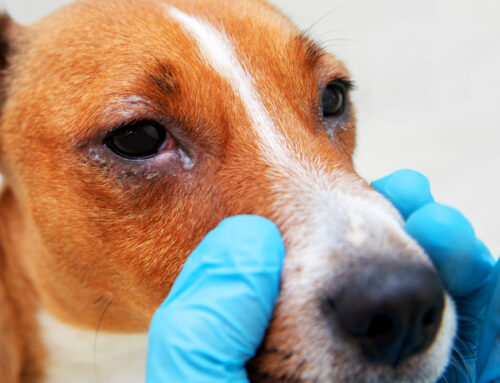Tumors are abnormal cell collections that can form anywhere on a pet’s body, including the tissues inside, on, or around the eyes. With specialized care from a veterinary ophthalmologist, the prognosis for many pet eye tumors in pets is good, although treatment often requires surgical intervention. The Veterinary Vision Center team shares information about common eye tumors in pets and the surgical treatment options we may recommend for your furry pal.
Eye tumor types in dogs and cats
In dogs, the most common tumors we see arise from the oil-producing glands in the eyelid margin. They are almost always benign, but they can grow so large that they rub on and damage the cornea. These tumors can be removed under local anesthesia using laser or cryotherapy or under general anesthesia using traditional cutting and suturing techniques if the tumor is large. Eyelid tumors in cats are uncommon but may require more aggressive treatment.
We also see tumors arising from structures inside the eye. In dogs and cats, the most common intraocular tumors are melanomas or melanocytomas. Melanomas in other body areas can be aggressive cancers, but those originating in the eye have low metastatic potential—meaning they are unlikely to spread or to threaten overall health. However, eye tumors can affect the eyes’ functions and cause inflammation or painful glaucoma. Our veterinary ophthalmology team may recommend monitoring for certain tumor types or surgical treatment if we suspect that the tumor may spread. Cancer in pets’ other body areas can also spread to the eyes, which is called metastasis.
Eye removal surgery in pets
The most common surgical treatment for an intraocular eye tumor is enucleation (i.e., eye removal). This option is recommended when an eye tumor grows large enough to cause glaucoma or pain, or when the tumor has features that indicate a metastasis risk. In many cases, an eye with a tumor is still visual, which can make the best timing for surgery difficult to determine. However, removing the entire tumor is best achieved by removing the whole eye, which will also restore your pet’s comfort, and allow identification of the exact tumor type and predicted behavior based on histopathologic examination at the lab.
Vision-sparing tumor treatments in pets
Some tumors are small enough for us to treat without enucleating the entire eye. In these cases, the techniques we use depend on the location and may include:
- Cryosurgery — This technique uses extreme cold to destroy cancerous tissue on the eye’s surface or the eyelids.
- Laser therapy — Laser therapy destroys the tumor cells with light energy focused on the cells. Several laser types are used in veterinary ophthalmology to target the eye’s surface or to reach deeper structures, such as the iris, without harming healthy tissues.
- Tumor excision — Discrete tumors on the eye’s surface or in the eye’s front portion can sometimes be removed with careful use of an operating microscope. Intraocular surgeries to remove tumors in pets are tricky, because eye tissues are delicate, and complications can develop post-operatively.
Systemic cancer therapies in pets
If an eye tumor has spread to distant locations or has locally invaded tissues around the eye, we may refer your pet to an oncologist for systemic cancer treatments. Traditionally, these include chemotherapy, radiation, or a combined approach. Oncologic treatments are personalized to your pet’s tumor type and treatment goals, which often center around slowing or stopping tumor growth and reducing discomfort.
Navigating cancer in dogs and cats can be overwhelming, but our Veterinary Vision Center ophthalmology team can develop tailored treatment plans that prioritize your pet’s health, comfort, and well-being. In many cases, we partner with oncology specialists and your primary veterinarian to ensure your pet’s treatment achieves the desired outcome. If you suspect that your pet may have an eye tumor, or you have other concerns about their ocular health, contact us to schedule a visit.







Leave A Comment